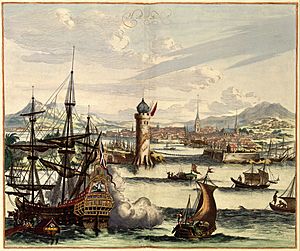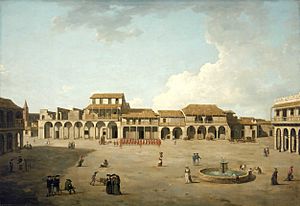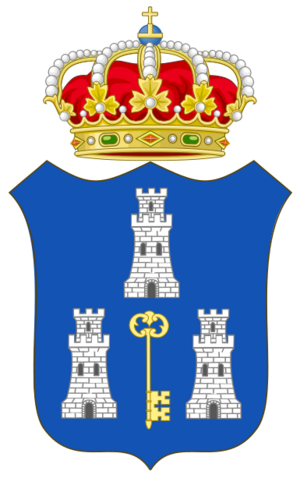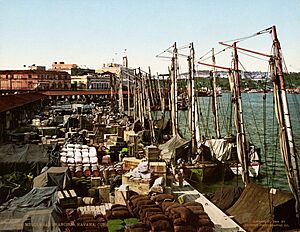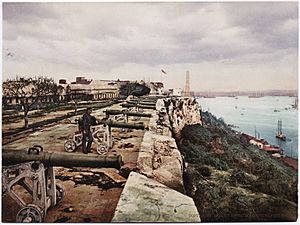History of Havana facts for kids
Quick facts for kids Havana |
|
|---|---|
| San Cristóbal de la Habana | |
 Map of the city and harbour of Havana in 1740 |
Havana is the capital city of Cuba. It was founded in the 1500s. It quickly became the most important city on the island. This was because it had a great port for ships traveling across the Atlantic Ocean. Many ships, especially the Spanish treasure fleet, used Havana as a major stop.
Contents
Havana's Story: A City's Journey
How Havana Began: Early Settlements

Spanish explorers first saw the area of Havana in 1508. This was during Sebastián de Ocampo's trip around the island. In 1510, the first Spanish settlers came from Hispaniola. They began to take control of Cuba.
Diego Velázquez de Cuéllar officially founded the city in 1514. It was first called San Cristóbal de la Habana. Its first location was on the southern coast of Cuba. However, attempts to build a city there failed.
Between 1514 and 1519, the city moved twice on the north coast. Its final and current location is next to a natural bay. This bay was known as Puerto de Carenas. The bay's excellent quality made it perfect for a port.
Bartolomé de las Casas, an early writer, described the bay as "very good" and able to "host many ships." He said few ports in the world were its equal. This amazing harbor was at the entrance to the Gulf of Mexico. It also had easy access to the Gulf Stream. This was a main ocean current that helped ships travel from the Americas to Europe. This made Havana grow quickly as Spain's main port in the New World.
Havana was the sixth town the Spanish founded on the island. Its name, San Cristóbal de la Habana, combines San Cristóbal, the city's patron saint, with Habana. Habana might come from Habaguanex, a Native American chief.
In the early years, Cuba was mostly a base for expeditions. These trips explored and settled other lands. For example, Hernán Cortés started his trip to Mexico from Cuba. Cuba did not have much gold or silver. So, many settlers moved to richer lands like Mexico. This left Havana and Cuba with fewer people for a while.
Pirates and the Spanish Treasure Fleet
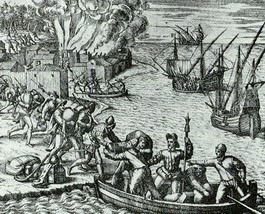
Havana started as a trading port. It often faced attacks from pirates and French ships called corsairs. In 1555, the French corsair Jacques de Sores attacked the city. He easily took Havana, stole from it, and burned much of it down. De Sores left without finding the huge riches he hoped for.
These attacks made the Spanish Crown build forts in major cities. These forts protected against pirates. They also helped Spain control trade with the West Indies.
To protect ships carrying treasures to Spain, the Spanish Crown created a large fleet. This was called the Spanish treasure fleet. All ships going to Spain had to meet in Havana Bay. They would gather from May to August. Then, the whole fleet would sail together to Spain by September.
This system greatly boosted trade and growth in Havana. Goods like gold, silver, wool, emeralds, and mahogany passed through Havana. Ships from all over the New World brought products here. The thousands of ships in the bay also helped Havana's farms and factories. They needed food, water, and other supplies for their long journeys.
In 1563, the Spanish Governor of Cuba moved his home to Havana. This showed Havana's new wealth and importance. It unofficially made Havana the capital of the island.
On December 20, 1592, King Philip II of Spain officially made Havana a "City." Later, the Spanish crown called it "Key to the New World and Rampart of the West Indies." Meanwhile, efforts to build and improve the city's defenses continued. The San Salvador de la Punta Fortress guarded the west entrance of the bay. The Castillo de los Tres Reyes Magos del Morro guarded the eastern entrance. The Castillo de la Real Fuerza protected the city center.
Havana's Growth: 17th and 18th Centuries
Havana grew a lot in the 1600s. New buildings were made from wood. They mixed different Spanish building styles. The city also built public monuments and religious buildings. Many important structures were finished during this time.
In 1649, a deadly sickness came from Cartagena, Colombia. It affected one-third of Havana's people. In 1665, Queen Mariana of Austria approved Cuba's official shield. It showed Havana's first three castles. The shield also had a golden key. This represented Havana's title as "Key to the Gulf." In 1674, work began on the City Walls. These walls were part of the city's defenses. They were finished by 1740.
By the mid-1700s, Havana had over 70,000 people. It was the third-largest city in the Americas. Only Lima and Mexico City were bigger.
British Takeover and Spanish Return
During the Seven Years' War, the city was captured by the British. This happened on June 6, 1762. A British fleet of over 50 ships arrived. They had more than 11,000 soldiers and sailors. They landed east of Havana. The British took control of the high ground. They began to bomb El Morro Castle and the city.
After two months, El Morro was attacked and taken. This happened after the brave defender Luis Vicente de Velasco e Isla died. The city officially gave up on August 13. Sir George Keppel, 3rd Earl of Albemarle then governed it for Great Britain. The British lost many soldiers to illness, especially yellow fever.
The British quickly opened trade with their colonies in North America and the Caribbean. This changed Cuban society fast. Havana grew and connected more with North America. But the British rule did not last long. Sugar merchants in London worried about sugar prices. This led to talks with Spain about colonial lands.
Less than a year after Havana was taken, the Treaty of Paris (1763) was signed. This ended the Seven Years' War. The treaty gave Britain Florida. In return, Spain got Havana back. The French suggested this trade. They feared Spain might lose Mexico if they did not agree.
After getting the city back, the Spanish made Havana the most fortified city in the Americas. They started building the Fortress of San Carlos de la Cabaña. This became the biggest Spanish fort in the New World. It took eleven years to build and cost a lot of money. Once finished, it was thought to be unbreakable. Other forts were also built. The castle of Atarés protected the shipyard. The castle of El Príncipe guarded the city from the west.
The Havana Cathedral was built in 1748 as a church. It became a cathedral in 1788. In 1796, the remains of Christopher Columbus were brought to the island. They stayed there until 1898. Then, they were moved to Seville Cathedral in Spain.
Havana's shipyard, called El Arsenal, was very busy. It used the many trees nearby. The Santísima Trinidad was the largest warship of its time. Launched in 1769, it was about 62 meters (203 feet) long. It had three decks and 120 cannons. Later, it had up to 144 cannons and four decks. This ship sank after the Battle of Trafalgar in 1805.
Havana in the 1800s
In the early 1800s, trade grew between the Caribbean and North America. Havana became a busy and stylish city. Its theaters hosted famous actors. Wealthy people built grand new homes. During this time, Havana was known as the Paris of the Antilles.
In 1837, Cuba built its first railroad. It was 51 kilometers (32 miles) long. It connected Havana to Bejucal. This railroad moved sugar from farms to the harbor. Cuba became the fifth country in the world to have a railroad. It was the first Spanish-speaking country.
Throughout the 1800s, Havana gained more cultural places. These included the Tacon Theatre, a very fancy theater. In 1863, the city walls were taken down. This allowed the city to grow larger. Wealthy families moved to new areas like Vedado and Miramar.
At the end of the 1800s, Spanish rule in America ended in Havana. This happened after the United States warship Maine exploded in its port. This event led the United States to invade the island. The 1900s began with Havana, and Cuba, under United States control.
Modern Havana: Republic and Revolution

From 1902 to 1959, during the time of the Republic, Havana grew a lot. Industries and businesses expanded quickly. Cuba recovered from war and became a successful country. Havana, as the capital, was called the Paris of the Caribbean.
Building was a big industry. Many apartment buildings and fancy homes were constructed. Luxury hotels, casinos, and nightclubs were built in the 1930s. These served Havana's growing tourism. Famous hotels like the Hotel Habana Riviera and the Hotel Nacional de Cuba had casinos. Havana became an exciting place for tourists. It offered marinas, car races, music shows, and parks.
Cuba's growth attracted many immigrants. Millions of people came to Cuba during this period. Many Spaniards moved there. Today, about a quarter of Cubans have Spanish immigrant ancestors.
Havana had a large middle class. It also became known for its lively entertainment scene. In 1958, about 300,000 American tourists visited the city. The American author Ernest Hemingway (1899–1961) lived in Cuba for 22 years. He wrote some of his famous novels there. He once said, "In terms of beauty, only Venice and Paris surpassed Havana." At that time, Havana had 135 cinemas. This was more than Paris or New York City.
After the revolution in 1959, the new government promised to improve public services and housing. However, Cuba faced shortages. This was due to changes in property ownership and a strong communist system. The U.S. embargo also made things harder. As a result, much of Havana today is in need of repair. Most of these economic rules remain in place.
After the Soviet Union broke apart in 1991, Cuba lost a lot of financial support. This caused a severe economic downturn. During the 1990s, known as the Special Period, Havana's government survived.
After 50 years of restrictions, the government began to rely more on tourism for money. They allowed foreign investors to build new hotels. In Old Havana, efforts have been made to rebuild for tourists. Some streets and squares have been restored.
In 2022, an explosion at the Hotel Saratoga killed at least 40 people.
See also
- Timeline of Havana history



